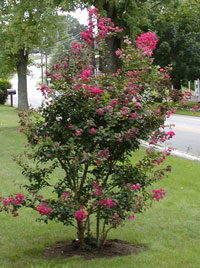Crape Myrtle (Lagerstroemia indica)
 |
Common Crape myrtle [KRAPE-MUR-tul] is an excellent ornamental plant for residential yards and gardens. It can be treated as either a shrub or small tree or, in colder regions where it dies back in winter, like a perennial plant. These trees boast handsome bark, lovely foliage and abundant colorful summer flowers. Deciduous, they lose their leaves in the fall. Once regarded as a primarily a southern tree, new types of Crape myrtle are now available which are hardy into those areas in the north with relatively mild winters. By nature rugged plants, crape myrtles tolerate drought, transplant easily, and require little care.
Size: In earlier times the typical crape myrtle of the South was a many-stemmed small tree that grew 15 to 20 feet tall. While this kind of crape myrtle is still available and popular, some newer hybrids have been developed that grow to a shrub-sized 5 or 7 feet tall. Some, called petites, or midgets, are even smaller, reaching only 12 to 24 inches during the growing season, then dying back for the winter. All are fairly rapid growers. The larger ones develop very attractive bark on their stems. A smooth, elegant gray, it eventually peels off to show variable grayish and brownish patches that are very eye catching.
Foliage: Crape myrtle leaves appear somewhat late in the spring, particularly on those plants that are new and young. They grow opposite each other, or sometimes in circles of 3, along shrub stems. Broadly oval, they grow to 2 to 4 inches long and 1 to 2 inches wide. They have smooth edges and rounded bases and tips. When they appear in the spring, they are a yellowish or bronze color that changes to lustrous medium green, slightly paler beneath, as they mature. In the fall they turn reddish, red-orange or yellow, depending on the variety, before they drop. White-flowered types have yellow fall foliage; pink and reddish ones have yellow, orange and red leaves in autumn.
Flowers and Fruit: Crape myrtle flowers appear in mid-summer and last until frost. Individual flowers measure about 1 1/2 inches across and develop in long upright clusters at the ends of each branch and twig of the current year's growth. These stunning clusters are 6 to 12 inch long and 3 to 5 inches wide on regular crape myrtles, much smaller on the dwarf or midget ones. The 6 petals of the flowers are wrinkled, suggesting crinkled tissue paper, hence the name "crepe" myrtle. Originally crape myrtle flowers were a basic purple-red color. Now they are white, red, pink, lavender, purple and even variegated. At the end of the season the flowers give way to dried, tan capsules with 6 compartments. About 1/2 inch wide, they remain on the tree most of the winter before releasing their winged seeds.
Crape myrtle Choices
`Apalachee' is slow grower, light lavender flowers; `Comanche' is slow grower, coral pink flowers; `Lipan' whitish-beige bark, lavender flowers; `Muskogee' large, especially mildew resistant, lavender flowers; `Natchez' has white flowers; `Osage' has pink flowers, slow growing; `Sioux' has dark pink flowers; `Peppermint Lace' has rose flowers with white edges; `Powhatan' compact (6x6), purple flowers, mildew resistant; `Tuscarora' pink/coral, maximum height 16 to 20 feet in 10 years, mildew resistant; `Crape Myrtlettes' grow to 3 or 4 feet, good for containers.
For more information see file on Selecting Shrubs.

